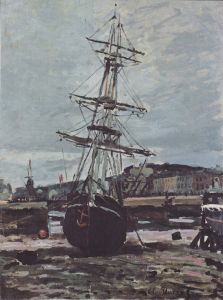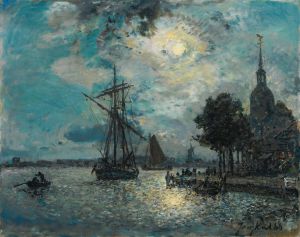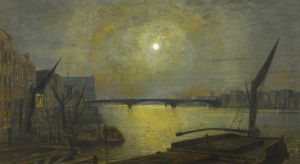
Whitby From Scotch Head, Moonlight On The Esk
A hand-painted replica of John Atkinson Grimshaw’s masterpiece Whitby From Scotch Head, Moonlight On The Esk, meticulously crafted by professional artists to capture the true essence of the original. Each piece is created with museum-quality canvas and rare mineral pigments, carefully painted by experienced artists with delicate brushstrokes and rich, layered colors to perfectly recreate the texture of the original artwork. Unlike machine-printed reproductions, this hand-painted version brings the painting to life, infused with the artist’s emotions and skill in every stroke. Whether for personal collection or home decoration, it instantly elevates the artistic atmosphere of any space.
John Atkinson Grimshaw's painting Whitby from Scotch Head, Moonlight on the Esk is a notable example of the artist's mastery in capturing atmospheric effects and nocturnal scenes. Grimshaw, a British painter born in 1836, is renowned for his evocative depictions of moonlit landscapes, urban streets, and harbor scenes, often characterized by their meticulous attention to detail and dramatic use of light and shadow.
This particular painting portrays a view of the River Esk in Whitby, a historic seaside town in North Yorkshire, England. The perspective is taken from Scotch Head, a location that provides a vantage point overlooking the river and its surroundings. The scene is bathed in moonlight, a signature element of Grimshaw's work, which lends the composition a serene and almost ethereal quality. The moonlight reflects off the surface of the water, illuminating the river and casting soft shadows on the surrounding buildings and landscape. The painting captures the quiet, contemplative atmosphere of a moonlit night, a recurring theme in Grimshaw's oeuvre.
Grimshaw's technique in this work demonstrates his ability to blend realism with a sense of romanticism. He was known for his use of thin glazes of paint, which allowed him to achieve a luminous effect, particularly in his depictions of light sources such as the moon or gas lamps. This meticulous approach to layering paint contributes to the painting's depth and realism, while also enhancing its dreamlike quality.
The town of Whitby, depicted in the painting, has a rich maritime history and is famously associated with Captain James Cook, who apprenticed there, as well as with Bram Stoker's novel Dracula. While Grimshaw's painting does not explicitly reference these historical connections, it captures the timeless charm and atmospheric allure of the town, particularly as seen under the light of the moon.
Grimshaw's work was highly regarded during his lifetime, and he enjoyed considerable success as a painter. However, his reputation declined somewhat after his death in 1893, only to be revived in the 20th century as art historians and collectors rediscovered his unique contributions to Victorian art. Today, his paintings are celebrated for their technical skill and their ability to evoke mood and emotion.
Whitby from Scotch Head, Moonlight on the Esk exemplifies Grimshaw's talent for transforming ordinary scenes into poetic visions, making it a significant piece within his body of work. The painting continues to be appreciated for its atmospheric beauty and its representation of Grimshaw's distinctive style.












